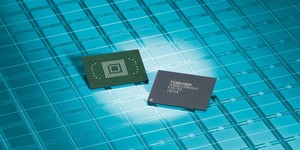
SandForce
Used in: ADATA F599, Corsair F-Series, G.Skill Phoenix and Phoenix Pro, OCZ Vertex 2, OCZ Vertex 2E, OCZ Agility 2,. OCZ Vertex Special Edition (100GB and 50GB), Patriot InfernoThe new hot property in SSD town, the SF-1200 drive controller delivers great speeds thanks to its approach of compressing data on the fly and writing less data. Because of the reliance on the controller rather than the flash memory, every SandForce drive of a range should perform identically, regardless of its capacity.
Sequential read speeds of up to 280MB/sec and sequential write speeds of 270MB/sec are joined by similarly rapid random read and write speeds of over 45MB/sec, with some drives, such as the Corsair F series, OCZ's Vertex 2 and G.Skill's Phoenix Pro also offering the 'special' SF-1500 firmware which boosts random write speeds even higher.
One let down is that due to its reliance on compression for performance, speeds can differ depending on whether the drive is handling compressible files or not. The issue of spare area is also a worry – the first SandForce drives shipped with 128GB of NAND but just 93GB of formatted capacity. This is being resolved now, with drive partners releasing 60GB, 120GB and 240GB drives which not only perform identically, but ship at a similar price to the 50GB, 100GB and 200GB drives.
Verdict: A fast controller that's great for a boot drive or games and applications, but look for 60GB, 120GB or 240GB drives as these are better value than 50GB, 100GB and 200GB models. The reliance on file compression can lead to varying performance, but such situations will be in the minority in consumer systems.

SandForce drives have overcome initial over-over-provisioning issues and are now much better value, as well as being ninja-speedy
Marvell
Used in: Crucial C300 seriesRequiring a SATA 6Gbps port to get the best out of it, Marvell hastaken the traditional SSD architecture of cache, controller and NAND and gone to town, using a dual-core ARM9 CPU as the drive controller, 128MB cache and ultra-high-speed ONFI 2.1-certified NAND.
The result is a drive that can hit 350MB/sec in sequential read speeds with brilliant random performance to match; both random read and write speeds climb over 50MB/sec. The only area the Marvell controller doesn’t dominate in is sequential write speed, where it manages 230MB/sec - this is pretty much the maximum without using a compression technology similar to the one that SandForce controllers currently use. Smaller drives also offer lower sequential write speeds, with the 64GB drive managing just 70MB/sec to the 256GB’s 230MB/sec.
Verdict: Insanely fast at everything, making it the most desirable SSD on the market for fast storage or as a boot drive. You'll need a fast SATA 6Gbps port to get the most from it (the most reliable method is via an expansion card) and the 128GB isn't quite as competitively priced as the 64GB and 256GB versions.

The Marvell-powered C300 256GB is the fastest SSD available today

MSI MPG Velox 100R Chassis Review
October 14 2021 | 15:04








Want to comment? Please log in.